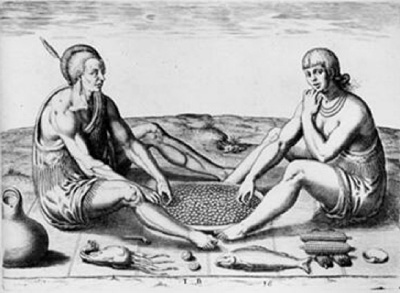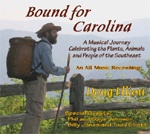It’s been a good mast year here in the Southern Appalachians. That means the oaks, hickories, and walnuts have been very productive. (Though in some areas the nuts are getting roasted by the wildfires!) (For an enlightening perspective on the fires check out Clint Calhoun’s recent blog:
http://clintcalhounadventures.blogspot.com/2016/11/fire-on-mountain-blessing-or-curse.html
One of the most interesting native nuts is the chinquapin, Castanea pumila, (sometimes spelled “chinkapin”). This shrubby miniature chestnut produces prickly burs with delicious, tiny, dark brown nuts no bigger than a filbert. They can be peeled and eaten raw, boiled, or baked.

The name, “chinquapin” is a corruption of “chechinquamin,” the name Captain John Smith recorded in his history of Virginia. Smith noted that, “they esteeme (it) a great daintie” and that they were dried and stored as part of the community’s regular store of provisions. “Of their Chesnuts and Chechinquamins (they) boyled them (to) make both broath and bread for their chiefe men at their greatest feasts.” Some translate the name to mean “prick” or “jab” and “eye” with the suffix “min” which is the Algonquian root referring to “food” or “grain”, as in the words, “persimmon”, “asimin” (pawpaw), and “menomin” (wild rice).

This 16th century engraving by Theodore De Bry depicts natives with some of their traditional foods. It looks like this romantic couple is enjoying a tray of chinquapins.
The chinquapin is found from Pennsylvania through most of the southeast and west to east Texas There’s an endangered midwestern Ozark chinquapin (C. ozarkensis) which, like our eastern chinquapin is threatened by the same blight that took down the American chestnut.
There are two other genera of nut bearing trees known as chinquapins. Chrysolepis is a small genus endemic to the western United States. The genus Castanopsis is indigenous to Asia. There is also the chinquapin oak which is so named because its leaves resemble those of the chinquapin.
 Twenty-some years ago when we had a little boy with big brown eyes crawling around the house, occasionally a neighbor would remark, “Well look at the chinquapin eyes on that boy!” I am amazed and delighted to be around country folks who are so familiar with this somewhat rare nut that it has become an adjective in their vocabulary.
Twenty-some years ago when we had a little boy with big brown eyes crawling around the house, occasionally a neighbor would remark, “Well look at the chinquapin eyes on that boy!” I am amazed and delighted to be around country folks who are so familiar with this somewhat rare nut that it has become an adjective in their vocabulary.
Click here for a recording of a medley of two old fiddle tunes: Chinquapin Hunting and Rock the Cradle Joe performed by Walt Michael and Company.
Feel free to check out the products page of my website for the Holiday Sale!
http://www.dougelliott.com/products.html
Special Bonus:
With every order we will include a free copy of the 64 page book,
 Crawdads, Doodlebugs and Creasy Greens
Crawdads, Doodlebugs and Creasy Greens
Songs, Stories, and Lore Celebrating the Natural World
Discover how to catch crawdads, puree pawpaws, gobble greenbriers, noodle catfish, tickle trout, cook squirrel brains, twist a critter out of its hole, and predict the weather with a persimmon seed. Learn how to greet a doodlebug, and find out which rabbit’s foot is actually the lucky one. Hear tales about Queen Elizabeth when she was courted by a frog, Copper John Higgins when he swallowed a lizard, and Davy Crockett when he tried to grin a squirrel out of a tree. The book features two dozen favorite old time, and contemporary songs, more than 90 original illustrations and a plethora of stories and lore. ($5 value –free with any order!)
 Bound for Carolina CD
Bound for Carolina CD
A Musical Journey Celebrating the Plants, Animals and People of the Southeast
An All Music Recording featuring the original tune, Big Black Snake
From Oh Susanna to Old Joe Clark, from the crawdad hole to the railroad yard, Elliott wails on his harp and sings a collection of blues, contemporary, traditional, and old-time songs celebrating country life, the natural world, and especially the people, the plants, the critters, and the rich environment and culture of southeastern North America. Elliott is accompanied by fiddles, guitars, banjos, mandolins, bass, drums, buckets, bottles, rattlesnake rattles, frog croaks and even a few blue yodels. This all-music recording features seven newly recorded songs as well as 14 favorites from previous albums. Special guests on this project include, Phil and Gay Johnson, Billy Jonas, Wayne Erbsen, and Todd Elliott.
Featured tunes:
Oh Susanna • Froggie Went a’ Courting • Big Black Snake • Rattlesnaking Papa • Old Joe Clark • Strawberry Picking • Dandelions • Creasy Greens • Root Blues • Crawdad Hole • Mole in the Ground • Bullfrogs on Your Mind • Bulldog on the Bank • Cluck Ol’ Hen • Who Broke the Lock • Ain’t No Bugs on Me • Sail On Honeybee • Bile them Cabbage • Left Hind Leg of a Rabbit • West Virginia • All Around the Water Tank
Normally $15 — NOW only $10 http://www.dougelliott.com/products.html
 An Evening with Doug Elliott DVD
An Evening with Doug Elliott DVD
Stories, Songs, and Lore Celebrating the Natural World
Elliott performs a lively concert of tales, tunes, traditional lore, wild stories, and fact stranger than fiction–flavored with regional dialects, harmonica riffs, and belly laughs. One moment he is singing about catfish, the next he’s extolling the virtues of dandelions, or bursting forth with crow calls. He also demonstrates basketry, ponders the “nature” in human nature, tells wild snake tales, and jams and jives with his fiddler son, Todd.
Normally $20 — NOW only $15 http://www.dougelliott.com/products.html
